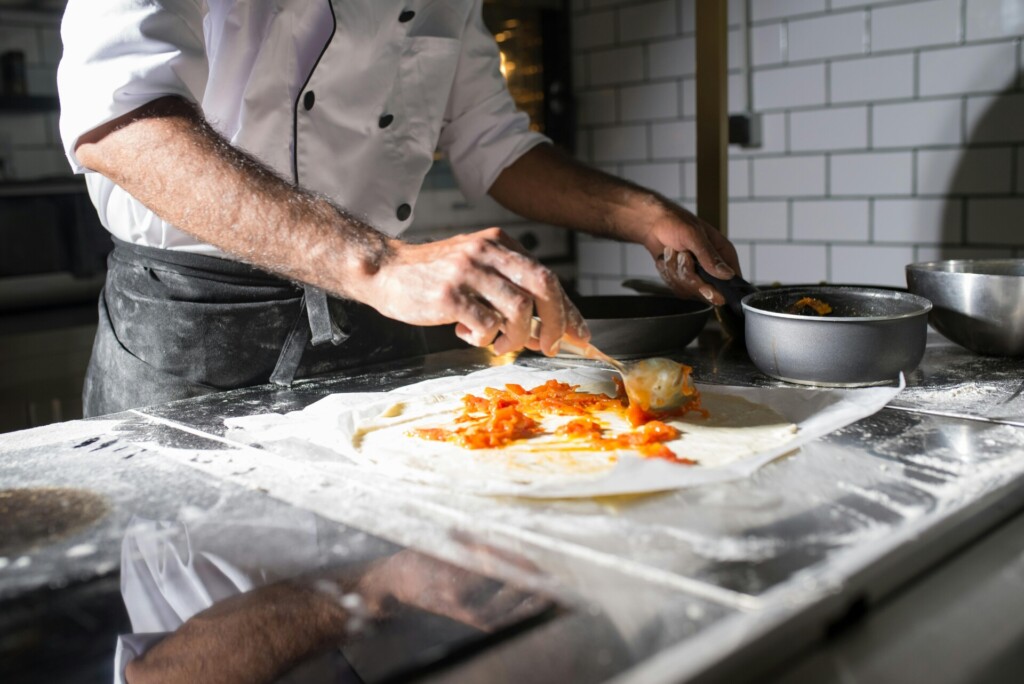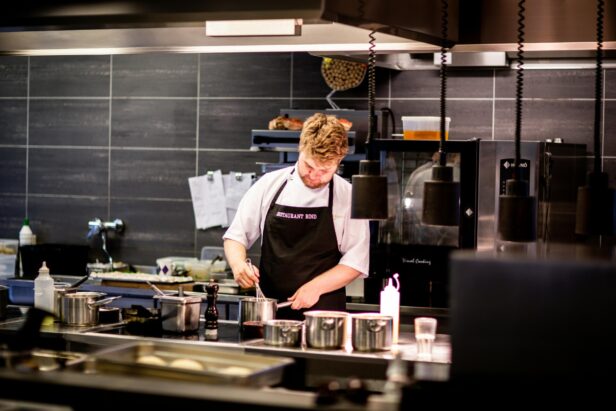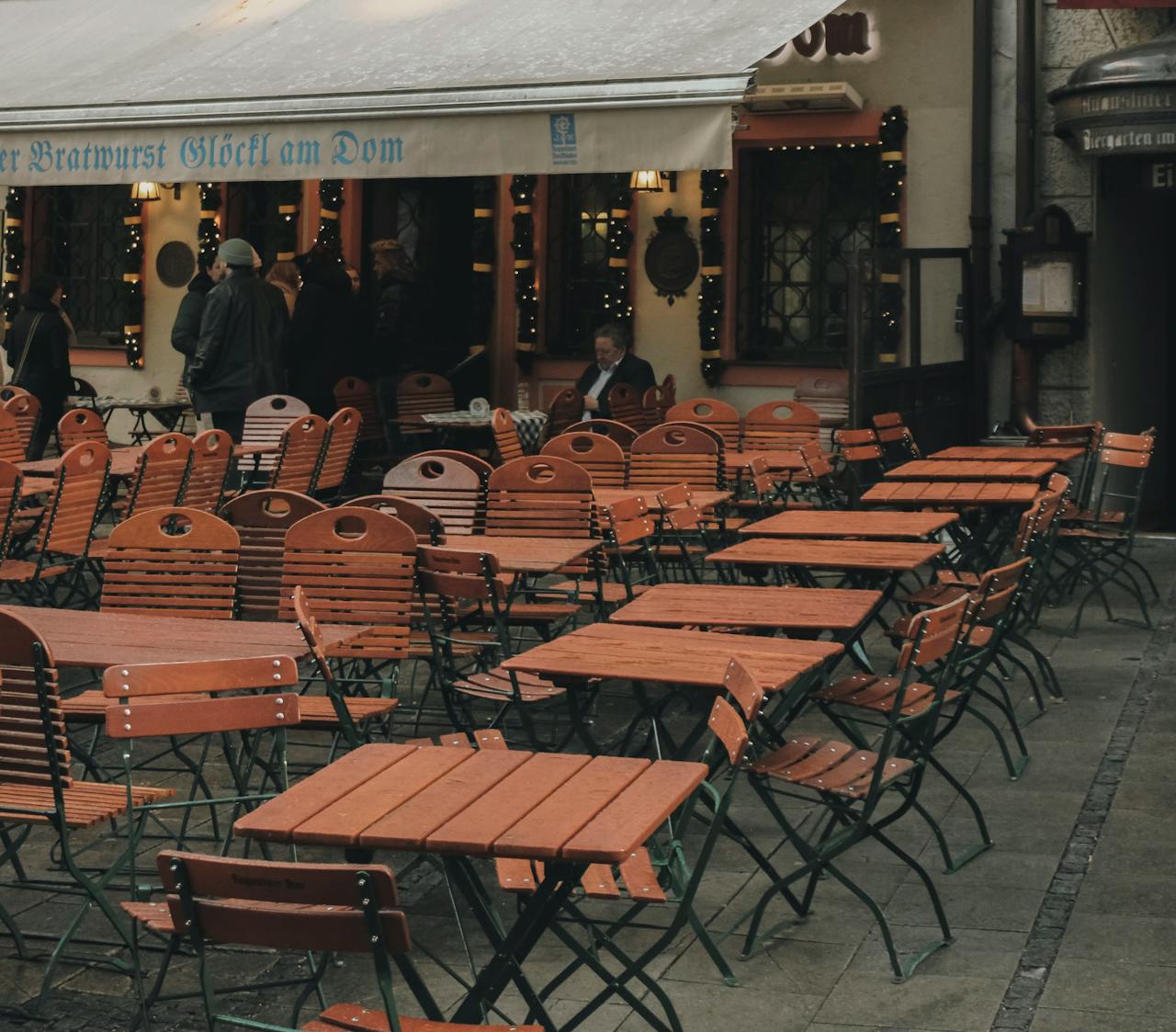In the high-stakes world of commercial food service, the walls that surround your kitchen are more than just a backdrop—they are crucial to food safety and regulatory compliance. At EB3 Construction, we understand that choosing the right wall materials can impact a kitchen’s ability to meet stringent health codes and endure the daily rigors of a busy culinary operation.
Commercial kitchen walls face numerous challenges: searing heat from stoves and ovens, constant moisture from cleaning and food preparation, grease splatters, and potential impacts from heavy equipment. In addition to these physical demands, surfaces must comply with various health department regulations and food safety standards. This is a significant requirement, but one that the right materials can fulfill.
Two materials often dominate discussions with clients: stainless steel and Fiberglass Reinforced Plastic (FRP) panels. Each offers unique advantages, and understanding their differences is essential for making an informed decision that balances performance, cost, and long-term value.
As we delve deeper into each option’s pros and cons, consider that the best choice for your project will depend on factors such as budget, specific use case, and local code requirements. Our goal is to equip you with the knowledge to make a decision that will benefit your kitchen for years to come.
What Are the Key Selection Criteria for Commercial Kitchen Wall Materials?

When choosing materials for commercial kitchen walls, six essential criteria should guide our decision-making process:
Durability
Commercial kitchen walls face constant traffic, impacts, and physical stress. We select materials that can endure the daily wear and tear of a busy kitchen environment, maintaining their integrity over years of heavy use. This includes resistance to dents, scratches, and other damage from equipment and staff movement.
Hygiene
In an environment where food safety is crucial, wall materials must adhere to the highest standards of hygiene. We opt for non-porous surfaces that resist bacterial growth and do not harbor pathogens. This attribute is vital for maintaining a sanitary kitchen and passing health inspections.
Ease of Cleaning
Regular and thorough cleaning is vital in commercial kitchens. We prioritize materials with smooth surfaces that are easy to wipe down, pressure wash, and disinfect. The ability to withstand harsh cleaning chemicals without degradation is also a key factor we consider.
Installation Requirements
The complexity and time required for installation can significantly affect kitchen downtime and labor costs. We evaluate materials based on their installation process, including whether they require special tools, adhesives, or skilled labor. Materials that can be installed quickly with minimal disruption to kitchen operations are highly valued.
Fire Performance
Safety is a top priority in commercial kitchens, where the risk of fire is ever-present. We select materials with appropriate fire resistance ratings to comply with local building codes and safety regulations. This includes considering factors like flame spread and smoke development indices.
Cost Considerations
While upfront material costs are important, we adopt a holistic view of expenses. This includes factoring in installation labor, long-term maintenance needs, and the expected lifespan of the material. We aim to balance initial investment with long-term value and performance.
By carefully weighing these criteria, we ensure that the wall materials we select for commercial kitchens meet the demanding requirements of the environment while providing lasting value and performance.
| Wall Material | Durability | Hygiene | Ease of Cleaning | Installation | Fire Performance | Cost |
|---|---|---|---|---|---|---|
| Stainless Steel | Highly durable; resistant to corrosion, rust, and stains | Non-porous, antimicrobial | Easy to clean; smooth surface reduces seams | Requires specialized installation | High melting point; not fire-rated | High cost due to material and installation |
| Fiberglass Reinforced Plastic (FRP) | Good impact resistance; potential moisture vulnerability at seams | Moisture resistant but potential mold risk at seams | Can be cleaned with soap and water, withstands pressure washing | Challenging; requires skilled installation and adhesives | Varies from Class C to Class A | Lower material cost, higher installation cost |
| PVC Panels | Very durable; impact-resistant | Non-porous, smooth finish | Easy to clean with various solutions | Quick installation; tongue and groove system | Class A fire rating | Lower total installation cost |
How Does Stainless Steel Perform as a Kitchen Wall Material?
Stainless steel wall panels offer exceptional performance as a kitchen wall material, with several key advantages that make them ideal for commercial food preparation environments. However, there are practical considerations to keep in mind when evaluating stainless steel for kitchen walls.
One of the most significant benefits of stainless steel is its outstanding durability. These panels are highly resistant to corrosion, rust, and staining, allowing them to maintain their integrity even when exposed to moisture, heat, and food splatter. The non-porous surface of stainless steel prevents liquids, grease, and bacteria from penetrating, creating a hygienic barrier crucial for food safety. This impermeability also makes stainless steel panels exceptionally easy to clean and sanitize.
From a maintenance perspective, stainless steel excels due to its smooth surface and minimal seams. These panels are typically installed with tight joints, reducing the number of crevices where bacteria could accumulate. A simple wipe-down with appropriate cleaning agents usually suffices to maintain a sanitary surface, saving time and effort in busy kitchen environments.
Proper installation of stainless steel wall panels requires expertise and careful planning. The installation process involves thorough surface preparation, precise measurements, and the use of specialized mounting hardware. This complexity can affect both the timeline and cost of installation compared to some alternative materials.
Cost is another factor to consider carefully. Stainless steel wall panels generally command a higher price than alternatives like FRP or PVC panels. This premium is due to the raw material cost and the more complex manufacturing and installation processes involved. However, many clients find that the longevity, performance, and reduced long-term maintenance costs of stainless steel justify the initial investment.
In terms of aesthetics, stainless steel panels provide a sleek, professional look that many associate with high-end commercial kitchens. The reflective properties of stainless steel, especially in a brushed finish, can help brighten the workspace. However, fingerprints and water spots may be more visible on stainless steel surfaces, requiring more frequent cleaning to maintain a pristine appearance in high-traffic areas.
Ultimately, while stainless steel wall panels offer exceptional durability, hygiene, and ease of maintenance, they require careful consideration of installation requirements and budget. We work closely with our clients to determine if stainless steel is the right choice for their specific kitchen layout, usage patterns, and long-term operational goals.
What Are the Pros and Cons of FRP Panels for Commercial Kitchens?

FRP (fiberglass reinforced plastic) panels boast impressive strengths for commercial kitchen applications, having been initially developed for the demanding aerospace and automotive industries. However, their real-world performance doesn’t always align with marketing claims.
On the positive side, FRP panels offer good durability and impact resistance. They can endure the bumps and knocks typical in busy kitchen settings without cracking or chipping like tile might. FRP is also marketed as moisture-resistant, which is crucial for areas prone to splashes and high humidity.
However, the moisture resistance has some limitations. While the panel surface itself repels water, the seams between panels can be vulnerable. If not properly sealed, these joints may allow moisture to seep behind the panels, potentially causing separation from the substrate and creating spaces where mold could develop. This is a significant concern for maintaining proper kitchen hygiene.
Regarding cleaning, FRP provides flexibility. The smooth surface can be wiped down easily, and panels can even withstand pressure washing in many cases. However, caution is needed with harsher cleaning chemicals, as they may cause damage or discoloration over time.
One of the greatest drawbacks of FRP is the installation process. It’s notably challenging, requiring:
- Specialized handling to prevent warping or damage
- Difficult cutting that can produce harmful dust
- Application of messy adhesives
- Multiple skilled installers for proper alignment
This complex installation significantly increases the overall cost, despite the materials themselves being relatively affordable. It also means repairs or replacements can be disruptive and expensive.
Fire safety is another consideration. FRP panels come with varying fire ratings, from Class C to Class A. While higher-rated options are available, it’s crucial to verify that the specific panels meet local code requirements for commercial kitchens.
Overall, FRP panels provide a durable surface for commercial kitchens, but their benefits come with notable trade-offs in installation complexity, ongoing maintenance concerns, and potential hidden costs. Careful evaluation is needed to determine if they’re the best choice for a specific kitchen environment.
PVC Panels: An Alternative Worth Considering
PVC wall panels, like Trusscore Wall&CeilingBoard, offer significant advantages for commercial kitchens. Their mechanical strength and unique truss design provide durability, while their smooth, non-porous finish resists bacteria and is entirely moisture-resistant. This combination helps maintain a hygienic environment, essential for a busy kitchen.
A key benefit of PVC panels is their ease of maintenance. They can be cleaned with various solutions without degrading, and their stain-resistant properties ensure they maintain their appearance over time. This makes daily cleaning routines simpler and helps kitchens meet hygiene standards with less effort.
The installation of PVC panels is more straightforward compared to traditional options. These panels use a tongue and groove interlocking system that allows for quick and easy assembly. Unlike FRP, which often requires specialized hardware and adhesives, PVC panels can typically be installed directly to studs or over existing surfaces. This interlocking design speeds up the installation process and creates a more seamless finish with fewer weak points.
Safety is another area where PVC panels excel. Many options, including Trusscore Wall&CeilingBoard, achieve a Class A fire rating—the highest possible classification. This provides peace of mind and ensures compliance with commercial kitchen fire safety regulations.
From a cost perspective, PVC panels offer notable advantages. The simplified installation process means these panels can often be installed twice as fast as traditional alternatives, and in many cases, the job can be completed by a single installer. This efficiency translates to significant labor savings, with some estimates suggesting up to 33% lower installed costs compared to FRP panels.
Conclusion: Making the Right Material Choice for Your Commercial Kitchen

When selecting wall materials for your commercial kitchen, it’s crucial to consider both immediate needs and long-term factors. Stainless steel remains a top choice, offering unmatched durability, hygiene, and a professional aesthetic that can withstand the demands of a busy kitchen environment. However, its high performance comes with increased costs for materials and specialized installation labor.
FRP panels offer a balanced option, providing reasonable performance and moisture resistance. Yet, they have downsides—installation can be complex, requiring meticulous sealing to prevent sanitation issues over time. Long-term maintenance and potential wear in high-traffic areas are also important considerations.
PVC-based systems like Trusscore Wall&CeilingBoard are becoming increasingly popular as a viable alternative. They offer a good mix of performance, easy installation, and cost-effectiveness. The seamless design and built-in antimicrobial properties address many hygiene concerns associated with traditional materials, and the simplified installation process can significantly reduce project timelines and labor costs.
Ultimately, your choice should prioritize materials that meet or exceed regulatory standards for food safety and hygiene. Consider how well each option aligns with your kitchen’s specific demands, such as cleaning protocols and the potential for impacts and temperature fluctuations. Factor in not just the upfront costs, but also long-term maintenance requirements and the potential need for future replacements or repairs.
By carefully weighing these factors against your budget and operational needs, you’ll be well-equipped to select a wall material that enhances the safety, efficiency, and longevity of your commercial kitchen. For personalized guidance on choosing the right solution for your unique kitchen environment, don’t hesitate to reach out to our team of commercial construction experts.




